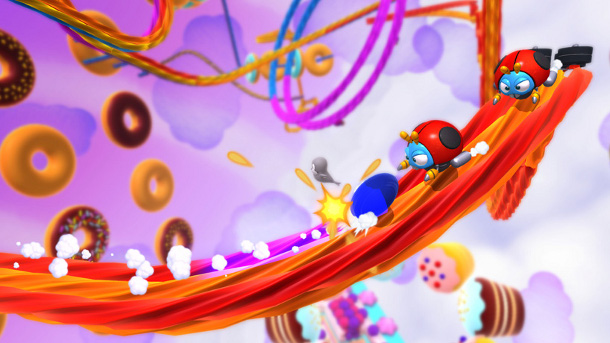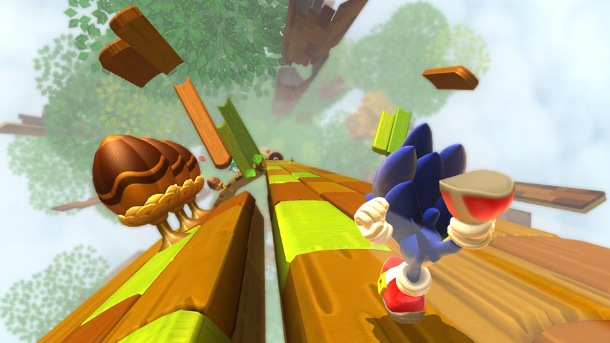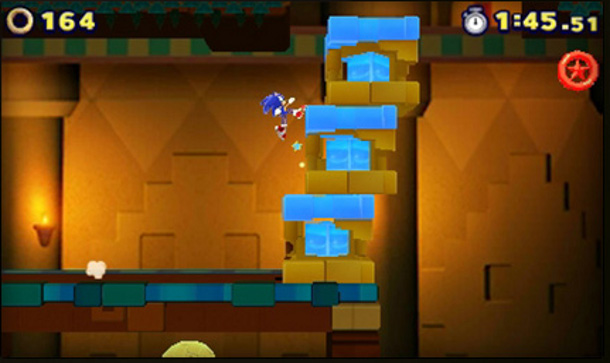
When Sega and Nintendo announced the partnership on the next Sonic game, the initial (awesome) trailer seemed to suggest Sega was utilizing Nintendo’s Mario Galaxy tech to reinvent the modern Sonic platformer. I was down like a clown in China Town, Charlie Brown.
During the Nintendo showcase that we attended, the company gave us some time browse the demo stations. Once they opened it up to the rest of the E3 attendees they promptly switched some of the Super Mario 3D World stations to Sonic Lost Worlds, so it was one of the first games I got to jump on. They were showing three different levels. The first was the Mario Galaxy inspired level, the second was a more traditional side scrolling level, the third was an “auto run” level.
The first stage, reminiscent of the “Green Hill Zone”, was what I was most excited to try out. There are some tweaks to how Sonic controls, mostly with the way he can run or spin. If you hold the right trigger Sonic starts running, if you hold the left trigger he rolls to a ball. Holding no trigger puts Sonic into a basic walk.
The approach to controlling speed is all well and good, but instantly playing I could tell Sonic really has not changed much from the last few games. The best I can summarize this is “herky-jerky” — there were issues with the hedgehog’s motions and movements that weren’t quite fluid. Sonic does have an ability to side run on walls or run up them, which is a nice change to keep the pacing right. The rotating Galaxy level seems to make the best use of Sonic’s traversal capabilities, and was probably the best level put on display the provided the most fun as classic Sonic platformer mechanics. The level was designed with nostalgia in mind and cool Galaxy style perspective changes.

The second level was a traditional side-scroller in a sweet Candy Land backdrop. This controlled more like the 2D portions of Sonic Colors for the Wii. If you have ever played that game, it should instantly describe the good and bad about this Lost World level. Again, here it doesn’t seem a lot has been fixed with Sonic’s movement, aside from holding a trigger to accelerate as the main difference.

The last level is like Sonic and the Secret Rings for the Wii. Much like the Sonic Dash game on iOS, Secret Ring‘s “auto-run” levels where you had to dodge out of the way of enemies, etc. This was by far the most confusing level I played. There were unclear cues to the player on what enemies could be auto targeted and how to destroy them, and the ability to move left and right didn’t feel as responsive as it needed to be. I died many times on this stage either running into enemies or running off an edge.

I also jumped onto the 3DS version of the game as well. It is not a direct remake of its Wii U big brother, but takes inspirations from it. There were two stages on display, again a 3D level and 2D level. The 3D level does rotate around like on the Wii U, but not to the same scale, and is a more standard level where the goal is to keep moving forward. Again, Sonic controls very much like on the Wii U. The wall running aspects of Sonic’s new moves seemed more necessary on the 3DS game and, like the Wii U, this level seemed to show the most positive foot forward for the game.

The second 3DS level, a 2D side scrolling level, was much different than the one being shown on console. This had a more Egyptian temple influence and actually incorporated more puzzle elements than is typical of a Sonic platformer. There were buttons that needed to be pressed to open a passageway, and I needed to time it so that an enemy would depress the button. I was required to use a new move of Sonic’s to send a slash kick to stun it, allowing me to progress forward. All fine and good in theory, but this slowed down the pace of the level and got annoying when I stunned the enemy just shy of the trigger, forcing me to wait again.
Sonic controlled as well as he has in recent outings for 2D levels, but the general level design was just not very fun. It was repetitive, and slow, and had sections blocked off until I killed a certain number of enemies before the door opened.
The best I can say about both games is that they look to pull tons of elements from Sonic games of yore, but I doubt either is the game that defines how to do a 3D Sonic game right.

1 Comment